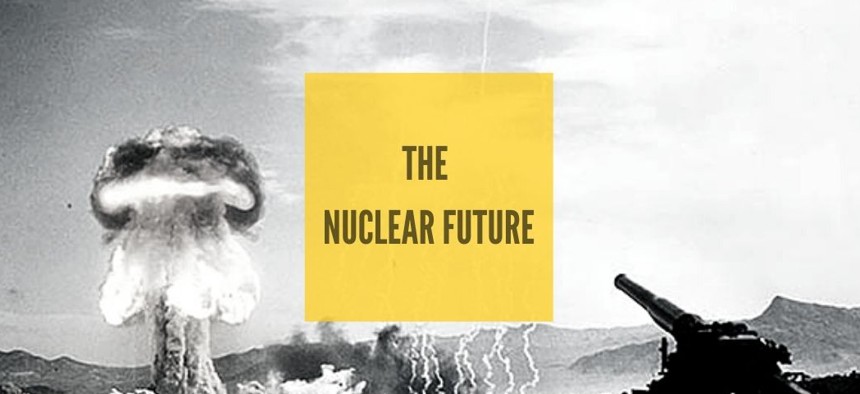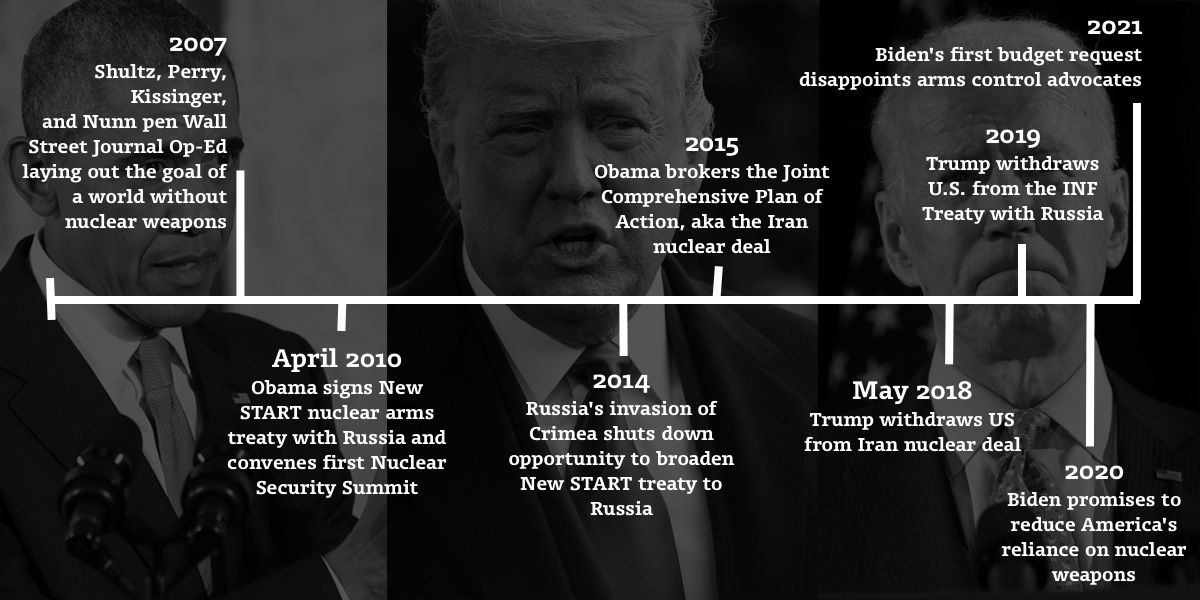
Nuclear arms control is a 20th-century idea. The fathers of the modern arms control movement are aging. DOD / Elizabeth Howe
Can Russia’s War Revive the Anti-Nuke Movement?
Amid aging leaders and new politics, arms-control advocates are using Putin’s invasion to renew attention to nuclear weapons.
SPECIAL REPORT: Part I | Part 2 | Part 3
In an April 5, 2009, speech in Prague, President Barack Obama set an ambitious, long-term goal: rid the world of nuclear weapons, which he called “the most dangerous legacy of the Cold War.” More than a decade later, Obama’s vision seems a fading dream to many leaders of the arms control and anti-nuclear weapons movements.
Tensions with other nuclear powers are growing. Russia’s invasion of Ukraine has triggered increasing concern about a nuclear standoff. Just before the invasion, Russia’s military staged provocative nuclear weapons drills last month. China is also growing its nuclear arsenal, and often clashes with the West over its territorial claims in the South China Sea. North Korea touts its Bomb; Iran edges toward developing one. In Washington, politicians are as divided as they have ever been, making ratification of a new arms control treaty almost impossible. And experts say both public interest and funding for arms control are in decline, as people care more about another existential threat: climate change. At least, they did before Russia started a new war in Europe.
All this has stalled or scuttled many arms control efforts over the past decade, and will make future efforts difficult, according to multiple experts.
America’s minimal engagement on the topic with Russia ground to a halt after its full-scale invasion of Ukraine in February, as the West imposed drastic sanctions, seized yachts belonging to oligarchs, and closed airspace to its airlines. Last week, Moscow pulled out of negotiations for a new Iran nuclear deal, citing the sanctions.
Any chance of an arms deal seems even slimmer for the foreseeable future, said Daryl Kimball, executive director of the Arms Control Association. “With the invasion of Ukraine, Putin has made any further progress on arms control and risk reduction impossible, at least for the time being,” according to an Arms Control Association brief published Feb. 28.
But even before Putin’s invasion, the arms control community’s outlook was grim.
“We haven’t achieved successes on the scale of the 1990s. On the other hand, we are sailing into much much stronger headwinds today,” said James Acton, co-director of the Nuclear Policy Program at the Carnegie Endowment for International Peace, in a January interview. “I think we have to recalibrate our notion of success.”
Nuclear arms control is a 20th-century idea. The fathers of the modern arms control movement are aging. George Shultz, a former secretary of State, passed away last year. Defense secretary-turned-activist William Perry is 94 years old and no longer conducting interviews, according to his daughter. Georgia Sen. Sam Nunn and former Secretary of State Henry Kissinger are 83 and 98 respectively. Some worry that the dearth of prominent new voices will allow the movement to die on the vine.
“We are on the cusp of a period when, if the institutions in the civil society area don’t have the resources to hire enough people and graduate programs don’t have as many postdoctoral fellowships, it will begin to have an effect on private, for-profit industry as well as government and Capitol Hill,” Kimball said.
‘A tremendous amount of momentum’
Two years before Obama’s speech, Schultz, Perry, Kissinger, and Nunn laid out the goal of a world without nuclear weapons in an op-ed for the Wall Street Journal.
“If you measure what we were trying to accomplish at that time, it really did become somewhat of a global movement,” Nunn said. “Obama made his statement in Prague and of course won the Nobel Peace Prize. All of those things gave it a tremendous amount of momentum.”
Within a year, the president and his Russian counterpart signed the New START nuclear arms treaty, limiting each country’s nuclear warheads and international continental ballistic missiles. The Senate ratified the pact in an overwhelmingly bipartisan vote.
In April 2010, Obama convened the first Nuclear Security Summit in April 2010 to work on security nuclear material and preventing nuclear terrorism. World leaders have since implemented more than three-quarters of the 260 commitments the meetings produced.

In 2015, he brokered the Joint Comprehensive Plan of Action, aka the Iran nuclear deal, which blocked Iran from getting a nuclear weapon in exchange for sanctions relief. The deal was celebrated by arms control advocates and heralded by Democrats as “one of the greatest diplomatic achievements of our time.”
But it was also the last major step Obama took toward his vision. Republicans slammed the Iran deal as “deeply flawed.” And in order to secure Republican support for New START, Obama dashed any hope that he might decline to replace aging U.S. nuclear missiles, bombers, and submarines. Two days before the vote, he wrote to lawmakers that his “administration will pursue these programs and capabilities for as long as I am president.”
Worsening geopolitics also reduced how willing countries were to talk to each other, especially about giving up some of their nuclear weapons.
“We had a number of other goals where there’s been a whole lot less progress. One of those goals was…to try to ease tensions in areas of regional conflict. As we see right now in Europe, almost the opposite has happened,” Nunn said in January, ahead of Russia’s invasion of Ukraine. “I would say it’s a mixed bag and missed opportunities, but the vision that we had of ultimately ridding the world of nuclear weapons, I think that’s still a vision that an enormous number of people still have in the world.”
Lynn Rusten, vice president of the Nuclear Threat Initiative’s Global Nuclear Policy Program, said the Obama administration intended to follow up New START with a broader treaty, but Russia’s invasion of Crimea in 2014 shut down any opportunity to do so.
“Efforts really stalled,” said Rusten, who previously served as the senior director for arms control and proliferation on the National Security Council. “We made proposals to Russia for an additional agreement. We wanted to bring in other classes of weapons, and we were willing to talk about other things Russia wanted to talk about….They didn’t bite. They weren’t willing to go lower at that time, then they invaded Ukraine. After that, there was just no opportunity for progress.”
Partisanship’s drag
Many nuclear arms control efforts were eliminated during the Trump administration. President Donald Trump withdrew the United States from the Iran nuclear deal in May 2018, and Tehran has violated the terms of the agreement five times since then, according to the Arms Control Association. In November, Gen. Frank McKenzie, commander of U.S. Central Command, said that Iran has made progress towards making nuclear weapons and is inching closer to enriching uranium to the level needed for a bomb.
The Biden administration launched efforts last year to try to re-enter the deal and a new proposal was nearing the finish line, but talks were abruptly paused indefinitely last week when Russia said it would withdraw from the deal unless American sanctions were lifted on its future business with Iran, the Washington Post reported.
“A pause in #ViennaTalks is needed, due to external factors,” Josep Borrell, the European Union’s foreign affairs chief, tweeted Friday. “A final text is essentially ready and on the table. As coordinator, I will, with my team, continue to be in touch with all #JCPOA participants and the U.S. to overcome the current situation and to close the agreement.”
In 2019, Trump also withdrew the United States from the INF Treaty with Russia, which had repeatedly violated the agreement. That treaty required both countries to eliminate any intermediate-range nuclear or conventional missiles.
The Trump administration also directed the development of a new low-yield nuclear warhead for Trident missiles.
The fact that Trump could undo so much of the progress made by Obama raises the question of how to make any lasting progress on long-term efforts like nuclear arms control when the American election cycle means policies can change every four years. The answer, says Rusten, is to solidify commitments with treaties, which require Congress’ support and are much harder to roll back.
But getting bipartisan support for anything in Washington has become extremely difficult, making passing a treaty nearly impossible.
“The reality is a Democratic president can’t get an arms control treaty ratified in the Senate,” Acton said. “That’s damaging to the United States. Look at the Iran deal….In an ideal world, it would have been better to make a treaty…but no matter how strong it was, very few Republicans would have voted for it….That undermines the ability of the United States to pursue deals that are in the national interest.”
During his 2020 campaign, Joe Biden promised to reduce America’s reliance on nuclear weapons, and his campaign website said that “the sole purpose of the U.S. nuclear arsenal should be deterring.” The Council for a Livable World endorsed Biden for president, saying that his “lifelong” commitment to nuclear arms control could “guide us down a path toward eliminating nuclear weapons.”
Because of this, advocates were optimistic that the new administration would prioritize nuclear arms reduction. Biden initially lived up to these hopes, working with Russia to extend the New START treaty just one week after taking office. But Biden’s first budget request in 2021 disappointed some arms control advocates because it continued many Trump administration programs, including development of low-yield nuclear weapons. Some experts cautioned against reading too much into Biden’s first budget, noting that the administration’s first Nuclear Posture Review and its second budget request are likely to be better indicators of its nuclear policy plans. That review was expected in January, but it and the president’s budget request may still be weeks or months away due to the attention required of Russia’s invasion of Ukraine.
The future fight
It’s not clear who will pick up the fight to cut nuclear weapons. But some are using the Ukraine conflict to sound new alarms after Putin’s dangerous rhetoric about nuclear weapons and Russian troops attacking and taking control of Ukrainian nuclear plants.
“You’re hearing more about nuclear threats now for good reason. It is not hype. It is not propaganda. We’re closer to the use of nuclear weapons by accident, miscalculation or madness than at any time since the early 1980s,” said Joe Cirinicione, the 72-year old distinguished fellow at the Quincy Institute and former president of the Ploughshares Foundation, on Friday.
Americans–when asked–overwhelmingly say the world should not have nuclear weapons. Two-thirds said that no countries should be allowed to have them, according to a Chicago Council poll in August 2020. Beyond nuclear weapons, as we get further from the Cold War, Americans are typically listing other existential issues like climate change as a higher-priority concern.
“The American people, certainly, and maybe even leaders have become awfully complacent about nuclear weapons. They think they won't be used, that deterrence won’t fail, and they add to our security without thinking about the fact that they could be used inadvertently or intentionally and what those consequences would be,” Rusten said.
It’s unknown how Russia’s war on Ukraine will change public opinion. But as public interest wanes, so does funding. The MacArthur Foundation, one of the major sponsors of nuclear arms control work, has announced that it would stop awarding grants on nuclear initiatives next year. Without that money, Kimball said, advocacy groups and academic programs specializing in nuclear arms control, which often serve as a training ground for people seeking to go into government, could struggle to hire. If outside groups can’t hire, that could mean officials entering government with less experience in this sector, he said.
Still, Kimball said there’s no shortage of early- and mid-career people working on arms control advocacy and nuclear policy, and that his organization always has more interested candidates than they do open positions. But other experts worry that, while there are lots of talented experts, there are no obvious high-profile public leaders like Kissinger, Schultz, Perry, and Nunn who could use decades of experience to make an appeal for nuclear arms control to a national audience.
“The folks who had leadership positions at the end of the Cold War are not going to be around for too much longer,” Acton said. “I do worry about a bit of a vacuum there.”
Others say the next generation is ready and willing to take up the fight.
“I think every older generation worries about that. Most of the time those worries are not well placed because bright young people are coming along,” Nunn said. “Schultz and Kissinger and Perry, in my view, would be difficult to be replaced in any generation in American history, but the bright folks are out there.”




